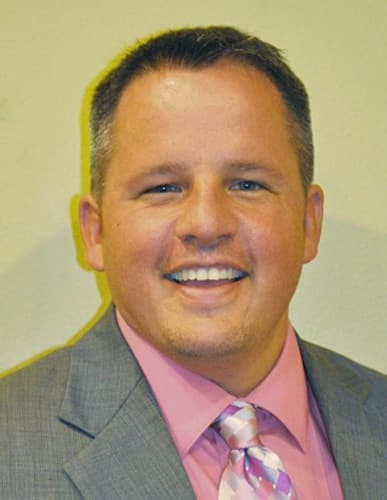Table of Contents
Changes at the local district level can impact globally with social sharing
Bill Adams, Superintendent of Janesville-Waldorf-Pemberton (JWP) Schools in Janesville, MN sees things from a global perspective. He believes changes made at the local district level have a way of becoming global changes through social media sharing. Adams chose to become superintendent for that very reason. Get into a position of power to push forth initiatives that improve the individual needs of students in a district and then share with other leaders in education.
Adams has adopted project-based learning and hybrid models that emphasize individual needs. Providing students with the what, when and how of learning are essential to Adams. Career academies and self-paced classes are examples of molding methods to the individual learner.
Meeting the student where they are rather than making the student fit into the system is important to Adams, but it takes commitment. In some ways, a district always runs the risk of teetering between change and going back to the old ways. There needs to be buy-in by the whole community, and it starts with district leadership vocalizing and sharing the plan.
“Paint or get off the ladder,” as Adams says and good things will come.
Interview
Host: Bill, I think what’s really interesting is the evolving nature in the role of a superintendent and the way in which we can communicate that out to the communities, at large, around the US. I’m finding that different skills are needed now and different personalities are occupying the superintendency.
What was it for you that said, “I want to be a superintendent,” and how has that role evolved for you?
Bill Adams: In terms of being a classroom teacher, it was awesome because I got to have an impact on a small group of kids within my classroom, and I had the luxury of seeing some phenomenal growth in individual students.
I wanted to have a larger impact on the world. And so, I took that step of being a building principal and I was able to change my building and change that system within that organization.
However, it wasn’t organizational change. I can only do bits and pieces of what I really wanted to do in education to benefit kids on a global level. And my calling, at that point was, in order for me to make those changes, I’d have to run or be in charge of a system to make that system move forward. The only way to do that was to take on the role of the superintendency.
With that being said, in the role now that I serve as a school district leader, I’m able to make a massive change that is having a global impact on students throughout the world. I’ve been contacted by Twitter and different means of communication to learn more about our system whether it be our professional development or our personalization of learning ─ whatever it is that we’re doing in our system.

I’ve been able to have that impact. Ultimately, the goal that I have in my life is to have a positive footprint ─ and not just the students at Janesville-Waldorf-Pemberton, but to be able to have a positive impact on students throughout the state, throughout the country, and throughout the world.
Host: What surprised you about the role of a superintendent that you wouldn’t have known or kind of predicted until you were in that position?
Bill Adams: Wow! I guess, a better question is “What didn’t surprise me?”
It’s much more a challenge than when I was in the peanut gallery, I thought, “how hard can it be?” You make a decision here and there and you work with the school board.
But until you get in the trench and you see the politics behind things in terms of what you need to think about behind every decision ─ How is this going to impact students? How is it going to impact staff? How was the contract integrated? When you think about the community, how is the community going to respond to this?
When you look at how the community responds, that’s who supports your operating levies and building bonds, and if you have to have their support and their trust.
So it’s just that balancing act to balance all those little details of being a superintendent to make sure you’re an effective leader, one that’s trusted and one that is supported.
I think the biggest surprise is the balancing act of all the things that you have to consider politically when making a decision.
Host: It keeps you on your toes, I’m sure. Speaking of that and those relationships that you have, obviously, outside of the school that you have to navigate successfully, let’s talk a little bit about funding and the ways in which districts are looking more globally in their perspective of incorporating the private sector ─ corporate America ─ to offset any challenges or budget shortfalls?
How do you look at that now given those experiences in ways that you can be progressive for your district in bringing in different or alternative funding sources?
Bill Adams: For our particular situation, we rely heavily on our local taxpayers for additional income to be able to operate. Honestly, about 20% of our overall budget comes directly from our local taxpayer which is a large percentage of our budget when you think about it from that perspective.
And if we don’t have that voter approved financial support, we’re in deep trouble financially. So we rely heavily on that particular portion of our revenue stream.
And then, being in south central Minnesota, we don’t have a lot of access to corporate funding and things of that nature. We do go out and seek donations and support from businesses and so forth maybe to advertise at our athletic events or on our live broadcast for athletic programs or our fine arts programs.
We don’t get a whole lot of funding from private sources. With that being said, we’ve had challenges just like other districts ─ facility challenges, one-to-one challenges, how to fund those projects, how to fund curriculum adoption, so forth and so on.
So we’ve had to get very creative in how we fund different programming and use complex processes to be able to fund things and be creative with what existing debt we have, what operating dollars we have coming in from local taxpayers to be able to accomplish some of the things we were able to accomplish.
When you talk about school finance, there is so much that goes into it that, again ─ it goes back to what surprises you about the superintendency ─ it’s also the complexity of the budgeting system especially in Minnesota.
We have a very large accounting code that we have to follow that is outside of the realm of accounting. We have to be creative within our own system to be able to fund things. In terms of corporate funding, we haven’t had to rely too much on that.
Host: Let’s take a shift to students. One of the things that we’re seeing ─ I think you might agree with this ─ is that we’re giving students the opportunity to take ownership of their learning in ways that we’ve never thought of or conceptualized when you and I went to school.
With that comes, how do we communicate what students are doing on a day-to-day basis? How do we report on that? How do we provide supports so that we are building engagement in a really meaningful manner, and then providing important information for teachers on how their students are doing? How do you look at the district level in a way that a lot of districts are now having conversations about?

Bill Adams: In terms of personalized learning and tailoring learning to each individual students, the way we define that in our district, is providing students with what they need, when they need it, and how they need it to be successful. And we believe if we do that for every individual student, the test results that are used for accountability purposes will take care of themselves.
So as opposed to focusing on assessment results, we focus on the individual child to ensure that they’re getting what they need, when they need it, and how they need it to be successful.
So we have piloted different programming. We’re making that trek down the personalized learning route for all students; creating career academies, pillars of learning such as project-based and self-based learning, hybrids style mixed in there with the traditional model because that’s what some kids need. And being able to provide students the opportunity of ─ if you, for example, wanted to take self-paced math, you could take math ─
Host: How did you know, Bill?
Bill Adams: Yes, exactly!
Host: That would have helped me, actually, going through school.
Bill Adams: Yes, think about that. You had to either hold back because the crew below you was holding you back, or you needed additional support but you weren’t getting the additional support because they had to go to Lesson 2.2 and you were on Lesson 2.1. That was stressful.
Now, we can look at each individual student, where they’re at, and we’re going to meet them where they’re at to get them to the next level, as opposed to we’re just going to teach to the middle and everybody’s got to come along.
So we’re having those conversations. We’re actually doing those things. We have math that is self-paced at high school. We have fifth-grade math that is doing some self-pacing. We’re at that tipping point of “we need to paint or get off the ladder” and if we’re going to paint, we need to paint this mural and know that we’re going to edit the job and make it look prettier as we go along.
It’s not a destination but it’s a journey.
We’re having those great conversations, and we have full support from our students, our community, and our staff to be able to get this done for kids.
And it’s about dang time.
About Bill Adams:
 Bill Adams started teaching at JWP in the early 2000’s. After years in the classroom, he went to Renville County West to serve as their elementary principal. After Renville, he joined Belle Plaine and served as elementary principal at Chatfield Elementary. In 2012 Adams returned to Janesville-Waldorf-Pemberton to his current role as Superintendent.
Bill Adams started teaching at JWP in the early 2000’s. After years in the classroom, he went to Renville County West to serve as their elementary principal. After Renville, he joined Belle Plaine and served as elementary principal at Chatfield Elementary. In 2012 Adams returned to Janesville-Waldorf-Pemberton to his current role as Superintendent.
This article was originally published on The Huffington Post by Dr. Berger

